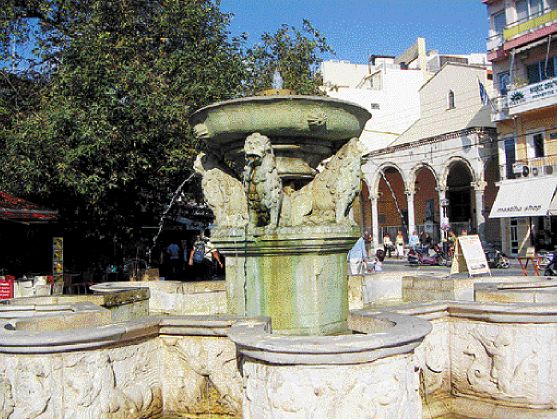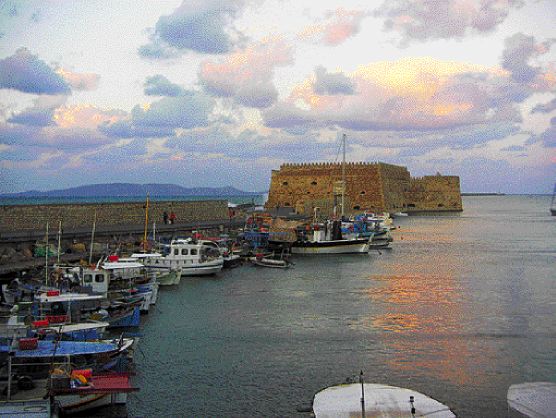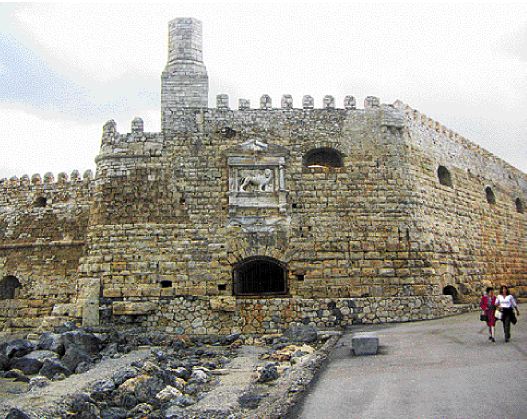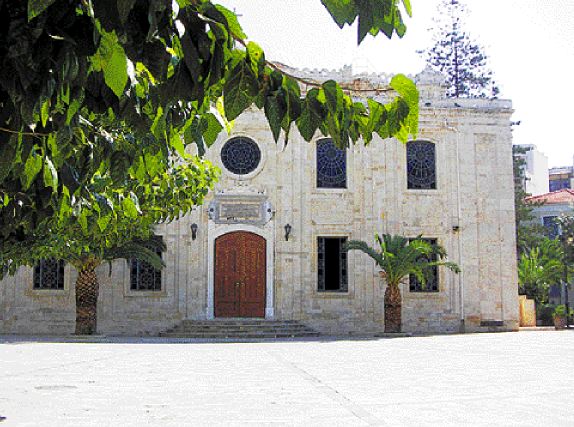 |
||
|
Iraklio: A Concrete City Redeemed
|
||
|
Crete's capital and the birthplace of Nikos Kazantzakis has considerable charms that can keep tourists hooked rather than passing through
By Julie Barrie |
 A city landmark on Venizelou Square, the Morosini fountain was named after the Venetian governor who built it in the 17th century |
|
Iraklio may be dismissed by most visitors to Crete today, but it wasn't always so. In fact, the city has a proud and turbulent history. It began as the small Minoan port of Katsamba and was given the name Heraklion in the Classical period. In 823, Saracens from North Africa invaded Crete and built a town and castle near the port. They called the town Kandak (meaning 'deep moat', after the trench they built around the castle walls) and made it their chief city. When the Venetians took over 400 years later, they kept Kandak (or Candia, as they renamed it) as Crete's capital and built massive fortress walls around it up to 15 metres thick in some places. These walls did their duty - after the rest of Crete fell to the Ottoman Turks in the mid-17th century, Candia held out for another 21 years, finally surrendering in 1669. In 1850 the Ottomans transferred their power base from Candia to Hania on the other side of the island. After Crete won its freedom, power was transferred back and the classical name of Iraklio was revived. Iraklio has been the capital of Crete ever since, but modern concrete buildings, traffic-filled streets and a persistent image problem have all contributed to keeping tourists passing through rather than spending time in the city. This is a pity because Iraklio has its charms and spending a couple of days there gives you a chance to visit the excellent market, go to a few of the less-known museums and see the fortifications. |
||
|
The best way to arrive in Iraklio is the ancient way - by sea. The ferries from Piraeus pull in at the modern port which gives you a good view of the fortress, so when you sail into the harbour you almost feel as though you are seeing the city as it would have been seen in Venetian times. The illusion doesn't last long, unfortunately, because you're soon swept up in a swirl of Iraklio traffic as you walk along the main road into town. The city centre is only a 10-minute walk from the port, and most of what you will want to see lies between the three central platias - Venizelou, at the top of 25-Avgoustou, the road that leads up to the town from the harbour front, Eleftherias to the east near the Archaeological Museum, and Kornarou at the top end of the market. |
 Sunset at Iraklio's harbour |
|
|
Platia Eleftherias is the place where Irakliots go for an evening stroll, and although it's surrounded by traffic there's a shady central area with palms and eucalyptuses and plenty of touristy cafes and restaurants about. Off Eleftherias are two of Iraklion's nicest roads - Korai and Dedalou. Korai is where Irakliot youth hangs out. It's one long cafe from beginning to end - an attractive narrow street with plenty of restaurants and expensive menus. Dedalou is parallel to Korai and is full of upmarket chain stores and tourist shops selling expensive Cretan olive oil, wine and soap - a good place to stock up on presents. At the other end of Dedalou is Platia Venizelou, a lively buzzing area of shops and cafes gathered around the Morosini fountain - built by the Venetian governor Francesco Morosini in the 17th century. The fountain is missing its statue of Neptune, but it's still a beautiful piece of sculpture with its four Venetian lions spouting water. Platia Venizelou was apparently built as a kind of miniature version of St Mark's Square in Venice, and while you have to use a little imagination to see it as such it's a pleasant place to laze away some time and is full of cafes with locals chatting over their coffee. |
||
| Across the road from Venizelou, at the top of 25 Avgoustou, are three of Iraklio's finest buildings. The Venetian Loggia was built in 1628 and was used as a meeting place for the town's nobility. It was almost completely reconstructed after being hit during the Battle of Crete and is now used to house the town hall. Just down from here is the Church of San Marco, rebuilt after an earthquake, converted into a mosque then converted back again. It's now used as an art gallery, and when we visited there was an exhibition of old photographs of Athens. The most beautiful building in Iraklio, though, has to be the church of Agios Titos. It's a little further down 25 Avgoustou from San Marco and it's set in a very pretty square. It was originally Byzantine, but was converted by the Turks for use as a mosque and was rebuilt several times, which is how it got its exotic present day looks. It was eventually reconsecrated as a church in 1925. There's a little row of cafes |
 Close-up of the 16th century castle at the harbours entrance |
|
| on the left side of the square - a nice place to stop for a rest, particularly if you are there on a Sunday morning when you can listen to the bells ringing and watch the families streaming out of church after the service. One of the cafes in the square is the very trendy Pagopoleion (the old Iraklio ice factory), which was taken over by the Germans during World War II, and a German inscription on the wall in the back room is still there (unfortunately, nobody could translate it for us). |
||
|
We wanted to walk around the city walls to get a sense of Iraklio's Venetian past, but access to them is almost impossible. The only way you can walk alongside them for any length is on the west side of the town, starting at St Andrew's Bastion on the seafront and going down to the Martinengo Bastion at the southernmost tip. We walked down to the Martinengo Bastion and then climbed the hill, looking for the grave of Nikos Kazantzakis, Greece's most famous novelist. Kazantzakis, who was born in Iraklio and died in 1957, aroused the wrath of the Greek Orthodox Church with his novel The Last Temptation of Christ, which was also placed on the index of forbidden books by the Roman Catholic Church. On his grave is his own epitaph (translated for us by a kind elderly Greek man who told us he was on a day trip from Hersonnisos) - 'I hope for nothing, I fear nothing. I am free.' From this peaceful spot you can look out over the city and harbour and to the mountains in the distance. |
 Originally Byzantine, the church of Agios Titos was rebuilt several times before acquiring its current shape |
|
|
If you are frustrated at not being able to gain access to the city walls then a good place to walk is along the jetty, where you can see the port fortifications up close. You can also go up to the top of the 16th-century castle at the harbour entrance. The jetty is about a quarter of a mile long and is a popular place for strolling and watching the huge ferries, like floating hotels, slipping in and out of the harbour.
One thing that we'd been told not to miss was Iraklio's excellent market. It's open Monday to Saturday and runs from the bottom of Platia Venizelou along Odos 1866, a narrow and attractive little street. You can pick up all sorts of things here including very inexpensive herbs (I found saffron for 1.50 euros) and Cretan cheese and wine, as well as meat, fruit and vegetables. Halfway along 1866 is a small street called Fotiou Theodhosaki, packed with taverns for the market traders - a much more authentic option for lunch than the touristy places in the main squares. At the top of the market in Platia Kornarou, sitting just behind a pretty cafe, is the Bembo fountain, which was put together by the Venetians from ancient fragments of marble. If you retrace your steps and turn left just before Platia Venizelou you come to Odos Kalokerinou. At the bottom, on the left, is the church of Agia Ekaterini, which has a Museum of Byzantine Icons. The church was a monastic school in the 16th century, and icon painting was one of the subjects taught. It's believed that El Greco studied here, and so did a contemporary of his, the painter Mihail Damaskinos. Six of Damaskinos' paintings take pride of place in the collection, including the Last Supper. The one museum you really shouldn't miss is the excellent Historical Museum down on the seafront, a little treasure trove of Cretan history. On the ground floor are maps of Crete from ancient to modern times as well as pottery, frescos and murals from many different periods of Cretan history. Upstairs is a collection of traditional costumes and the reconstructed study of Nikos Kazantzakis with first editions of his books in many different languages. The second floor is devoted to the Battle of Crete and you here can see filmed footage of the German parachute invasion of Crete in May 1941, projected onto the floor by an overhead screen, and read about the German occupation and the role of the famous Cretan resistance. If you're interested in Crete's role in the war then you might also want to visit the tiny Battle of Crete and Resistance Museum, behind the Archaeological Museum. All the labelling is in Greek, but if you don't read Greek don't let that put you off. Tucked away among the Greek flags, medals and costumes are various documents in English, written and signed by British army officers, concerning the German occupation and surrender. We had decided to leave the Archaeological Museum to the end of our stay, so we found ourselves here on our last afternoon. Across the road from Platia Eleftherias on the east side of town, this odd-looking low building is stacked with Minoan sculptures, pots, paintings and jewellery and can take a whole afternoon to walk around. It's best to have a guidebook with you so you can pick out what you want to see most, as you may feel a bit overwhelmed otherwise. We made straight for the first floor to see the famous frescos, including the Bull Leapers, the Dolphins and the Ladies in Blue - images familiar from a thousand postcards but even more beautiful when you see the originals. As well as exquisite pottery and sculptures there are also trays of intricate jewellery, including the gold ring of Minos and the famous necklace from the palace at Malia of two bees depositing a drop of honey. It's well worth leaving a whole afternoon to see the museum, and if you want to leave for a break you can get your ticket date stamped and then return later. We managed to pack a lot of things into our weekend in Iraklio. It's not Crete's prettiest city, but I was glad to find that it's a vibrant and energetic place that's full of interesting things to see. In spite of the double lure of the Archaeological Museum and Knossos, I'd always found it impossible to motivate myself to visit Iraklio while lying on a Cretan beach in the summer, but winter is the perfect time to go and Iraklio has plenty to offer. How to get there Photos by Julie Barrie |
||
|
(Posting date 26 May 2006)
All articles of Athens News appearing on HCS have been reprinted with permission. |
||
|
||
|
2000 © Hellenic Communication Service, L.L.C. All Rights Reserved. http://www.HellenicComServe.com |
||

